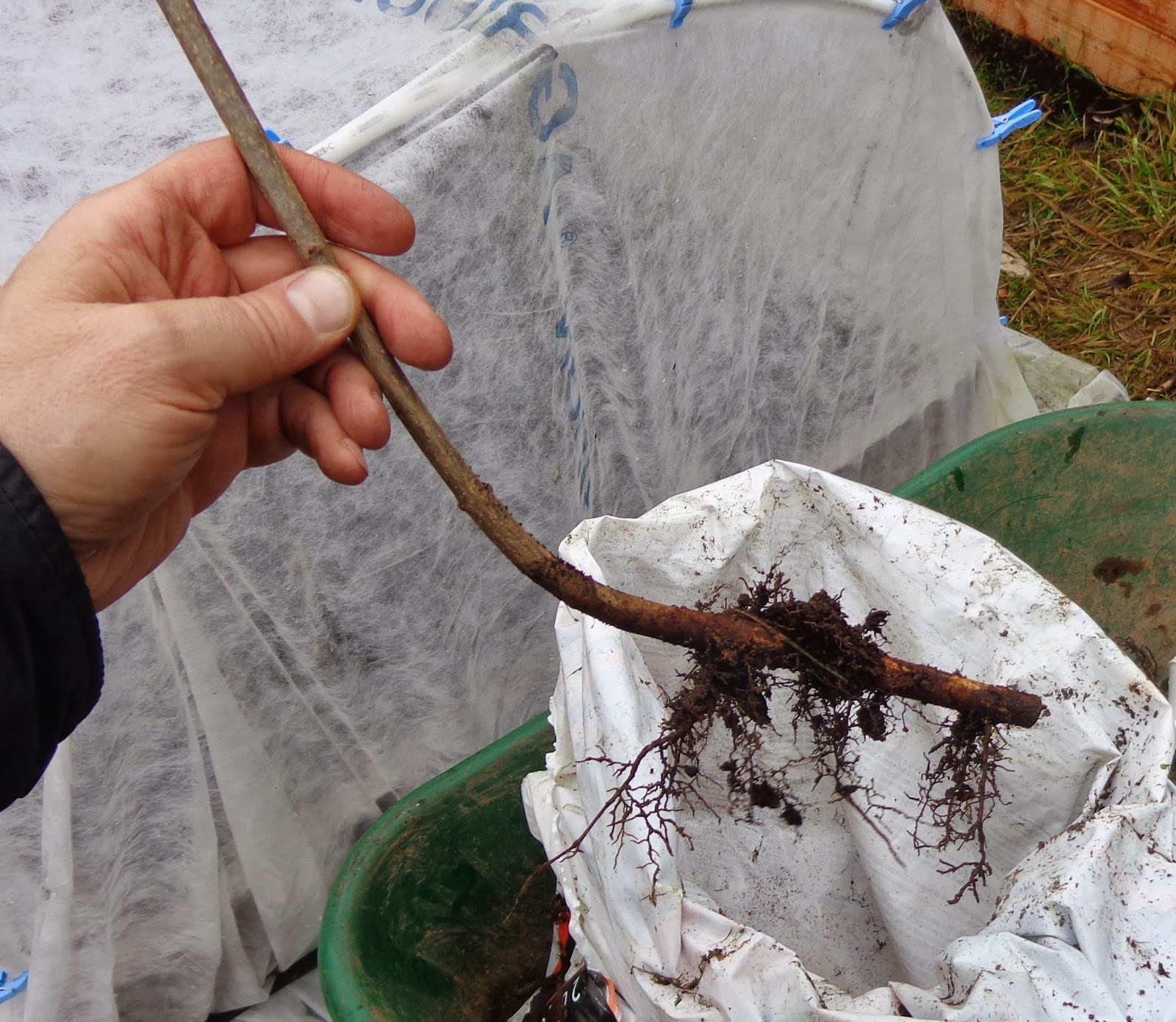Tuesday, January 07, 2014
Taking a start from a Lilac bush. Propagating a lilac bush by removing a sucker. 1.7.14
This sprout was about one foot away from a purple flowered lilac bush. It was an offshoot from that bush. I sliced through the main stem with the shovel. Then I dug it out.
Doesn't look too promising but I've seen less promising plants grow. So maybe.
I pruned the cut, to make it smooth instead of ragged. Pruned the top back a little. It is dormant, so there are no leaves to transpire and wilt. It will make new leaves at a size it can support with the roots.
Maybe the roots will extend a little during the winter, using reserve stored carbohydrates from the stem. That's why I didn't prune it back more.
I am determined not to add odds and ends into the vegetable bed. So now I've planted the lilac start in the vegetable bed. It is not in the way. The vegetables get TLC, so the lilac will also get some TLC for the next year.
If it survives and grows, I can move it to a permanent location next year.
This is the general concept. Traditional and super simple.
Find lilac bush with suckers.
Clear away weeds or stems that might be in the way.
Use shovel to slice through underground stem connecting sucker to parent bush. I try to do this close to the parent bush. That way I get more roots on the sucker.
Dig around sucker and carefully dig it up. It may not have a lot of roots.
Re-plant the sucker - now a new start of the lilac bush - in a sheltered location so it doesn't dry out this year.
This will work for other bushes that develop suckers - figs, forsythia, quince, etc.
I think the main thing is there are already a few roots. A hardwood cutting would be almost the same but without roots. It's more difficult to get roots growing from the stem, than to promote increase of root growth that has already begun.
The drawings are mine. I am not an artist.
Doesn't look too promising but I've seen less promising plants grow. So maybe.
I pruned the cut, to make it smooth instead of ragged. Pruned the top back a little. It is dormant, so there are no leaves to transpire and wilt. It will make new leaves at a size it can support with the roots.
Maybe the roots will extend a little during the winter, using reserve stored carbohydrates from the stem. That's why I didn't prune it back more.
I am determined not to add odds and ends into the vegetable bed. So now I've planted the lilac start in the vegetable bed. It is not in the way. The vegetables get TLC, so the lilac will also get some TLC for the next year.
If it survives and grows, I can move it to a permanent location next year.
This is the general concept. Traditional and super simple.
Find lilac bush with suckers.
Clear away weeds or stems that might be in the way.
Use shovel to slice through underground stem connecting sucker to parent bush. I try to do this close to the parent bush. That way I get more roots on the sucker.
 |
| Lilac Bush with suckers |
 |
| Newly planted lilac suckers |
Re-plant the sucker - now a new start of the lilac bush - in a sheltered location so it doesn't dry out this year.
This will work for other bushes that develop suckers - figs, forsythia, quince, etc.
I think the main thing is there are already a few roots. A hardwood cutting would be almost the same but without roots. It's more difficult to get roots growing from the stem, than to promote increase of root growth that has already begun.
The drawings are mine. I am not an artist.
Labels:
lilac,
plant propagation,
shrub propagation
Midwinter Gardening. Moving a Plum Tree. 1.7.14
 |
| Methley Plum. Digging it up. |
I thought it would be difficult to dig. It was easy. The move last year resulted in compact root system, not wide ranging. There was almost no root damage. The roots were about one shovel blade deep.
This was my usual method. Slice vertically in circle around tree. Scoop out a moat around tree, digging outside that sliced circle. Then slice under tree with shovel. No prying until I've fully sliced under the tree. It's easy this way, and not traumatic to the tree.
 |
| Transferred to a tarp. |
Those dog food bags have many uses in the garden. I never throw them away.
Then pick up using the tarp, not pulling on the trunk. Use wheelbarrow to move it to the truck. Then transfer into truck bed.
It's an overcast, wet day. Ground was soft. Not raining hard. Perfect for moving a tree.
 |
| Drove it to Battleground. On left is Helleborus. |
Almost in place. Hole is dug. I had a small jujube tree in this location. It's now moved to the bee garden near the other jujube. Those have been disappointing so far. Not much growth, still tiny. This is a good spot, close to the other plum trees. Before planting, I mixed a cup of lime with the back fill soil. I also added mycorrhizal inoculant. I don't think I will buy more of that. Probably not needed. But I have some left over so might as well use it.
 |
 |
| Covered with bird netting to deter deer. |
I don't have fencing to protect from deer, so I covered with bird netting. I sunk the posts into place a few weeks ago, anticipating this move.
Forgot to wrap the trunk to protect from chewing rodents. Other plum tree is not chewed, so it should be OK for the next day. I hope.
Labels:
Asian Plum,
Methley Plum,
tree transplanting
Sunday, January 05, 2014
Winter Images. 1.5.14
 |
| Beehive and Bird Feeders |
 |
| Fig Trees Frosty Morning |
 |
| All of the raised beds are built, filled, amended, weeded, and have a layer of compost. |
 |
| Charlie needs the warm blanket, because arthritis. Homework for me. Baigou likes the fire. |
Labels:
fig trees,
figs,
frost,
kitchen garden,
Raised Beds,
winter
Thursday, January 02, 2014
Shrub Order. Trial for Bee Forage and Deer Resistance. 1.2.14
I placed an order from forestfarms.com. I want to try some additional shrubs for bee forage and deer resistance.
The sterile Buddleias grew very nicely last year. By far the fastest growing shrubs in the yard, bloomed later into the summer and fall, and deer didn't touch them. We want to fill in between them, for a hedge. I want multicolored flowers. Currently, the hedge consists of Buddleia X Flutterby Peach Cobbler (3) and Blueberry Cobbler (1); Miss Ruby (1) and a yellow unknown I suspect is Buddleia globosa.
To fill in the Buddleia hedge, I ordered one sleeve of Flutterby Vanilla (off white), two sleeves of Honeycomb (yellow), and one sleeve of Asian Moon (purple). Combined with the current varieties, that will make a good color mix. They grow so fast, the sleeves - small starts - should fill in fine and bloom this year, and next year catch up with the older shrubs.
The down side for the sterile Buddleias, so far, is they can look weedy, and the early flowers on the long flower clusters dry up and turn brown, before the last flowers open. Which can look shabby, unless they are deadheaded despite the unopened end flowers.
I also ordered 2 sleeves of Philadelphus lewisii - Mock orange. Mock oranges are considered excellent bee attractants. The single-flowered ones are considered more bee friendly than modern double ones. They are native. They are reported as variably deer resistant.
And 2 Hebe hybrids. No photo - not available in public domain. Hebes are also thought to be good bee forage and deer resistant. They will go into the bee garden.
The sterile Buddleias grew very nicely last year. By far the fastest growing shrubs in the yard, bloomed later into the summer and fall, and deer didn't touch them. We want to fill in between them, for a hedge. I want multicolored flowers. Currently, the hedge consists of Buddleia X Flutterby Peach Cobbler (3) and Blueberry Cobbler (1); Miss Ruby (1) and a yellow unknown I suspect is Buddleia globosa.
 |
| Image Source: wikipedia Buddleia "Honeycomb" |
The down side for the sterile Buddleias, so far, is they can look weedy, and the early flowers on the long flower clusters dry up and turn brown, before the last flowers open. Which can look shabby, unless they are deadheaded despite the unopened end flowers.
 |
| Image source: Wikipedia Philadelphusn |
And 2 Hebe hybrids. No photo - not available in public domain. Hebes are also thought to be good bee forage and deer resistant. They will go into the bee garden.
Labels:
bee forage,
bee garden,
buddleia,
Hebe,
Philadelphus
Subscribe to:
Posts (Atom)



